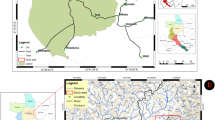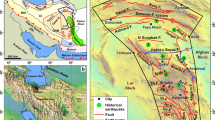Abstract
The Bhuj region, Kutch, India, is included in the highly seismic zonation map of India. The Kutch is a rift basin and so far has experienced three major earthquakes that are due to reverse fault mechanism, which in turn have been ascribed to compressive stresses. Origin of these stresses is considered to be due to north–south convergence of the Indian Plate with the Tibetan plate, and this has placed the entire Indian Plate under the compressive stress regime. Analysis of the stress pattern in the Bhuj region, therefore, has been carried out by extracting lineaments with the help of remote sensing data for the pre- and post-earthquake periods of 26 January 2001 earthquake. For this purpose, the area has been segmented into four sectors. The lineament frequency and the percent frequency from each sector and also for the whole area have been worked out. Resolution of stress on the principle of triaxial ellipsoid has been worked out for each sector and also for the whole area. There results a temporal change in the stress pattern in each sector and also for the whole area. However, the direction of horizontal maximum compressive stress for the whole area appears to be in N 10°E in the pre-earthquake period that has changed to N 10°W in the post-earthquake period. Thus, temporal change in the horizontal maximum compressive stress direction as N 23°E, inferred by Gowd et al. (J Geophy Res 97:11879–11888, 1992) to N 10°E prior to and N 10°W in the post-earthquake period, as inferred from lineament analysis and near parallelism of the lineament maxima with that of the North Kathiawar Fault and the Chambal Jamnagar Lineament along with the longer axis of the isoseismals of the Bhuj 2001 earthquake indicates a modification in the structural fabric of the region as well as a possibility of development of a major plane of weakness.






Similar content being viewed by others
References
Bapat A, Kulkarni RC, Guha SK (1983) In catalog of earthquakes in india and neighborhood from historical period up to 1979, Indian Society for Earthquake Technology, Roorkee, p 211
Bendick R, Bilham R, Fielding E, Gaur VK, Hough SE, Kier G, Kulkarni MN, Martin S, Mueller K, Mukul M (2001) The 26 January 2001 “Republic Day” earthquake, India. Seism Res Lett 72:328–335
Bilham R (1998) Slip parameters for the Rann of Kuchchh, India, 16 June 1819, earthquake, quantified from contemporary accounts in Coastal Tectonics. In: Stewart IS, Vita-Finzi C (eds) Geol Soc Lond Spl Publ 146:295–319
Biswas SK (1974) Landscape of Kutch—a morphotectonic analysis. Ind J Earth Sci 1:77–190
Biswas SK (1982) Rift basins in Western Margin of India and their hydrocarbon prospects with special reference to Kutch basin. Bull Am Assoc Pet Geol 66(10):1497–1513
Biswas SK (1987) Regional tectonic framework, structure and evolution of the western marginal basins of India. Tectonophysics 135:302–327
Biswas SK (2005) A review of structure and tectonics of Kutch basin, western India, with special reference to earthquakes. Curr Sci 88(10):1592–1600
Bureau of Indian Standards (BIS) (2002) Seismic Zoning Map of India, BIS, Publ
Chung WY, Gao H (1995) Source parameter of the Anjar Earthquake of July 21 1956, India and its seismotectonics implication for the Kutch rift basins. Tectonophysics 242:281–292
Dimri VP, Vedanti N, Chattopadhyay S (2005) Fractal analysis of aftershock sequence of the Bhuj earthquake: a wavelet-based approach. Curr Sci 88(10):1617–1620
Evans P (1964) The tectonic framework of Assam. J Geol Soc Ind 5:80–96
Gahalaut VK, Burgmann R (2004) Constraints on the source parameters of the 26 January 2001 Bhuj, India, earthquake from satellite images. Bull Seism Soc Am 94:2407–2413
Gowd TN, Sriram Rao SV, Gaur VK (1992) Tectonic stress field in the Indian subcontinent. J Geophy Res 97:11879–11888
Kayal JR, Mukhopadhyay S (2006) Seismotectonics of the 2001 Bhuj earthquake (Mw 7.7) in western India: constraints from aftershocks. J Ind Geophy Union 10(1):45–57
Kayal JR, De R, Saginaram, Srirama BV, Gaonkar SG (2002) Aftershocks of the 26 January, 2001 Bhuj earthquake in western India and its seismotectonic implications. J Geol Soc India 59:395–417
Mandal P, Pandey OP (2011) Seismogenesis of the lower crustal intraplate earthquake occurring in Kachchh, Gujarat, India. J Asian Earth Sci 42:479–491
Mandal P, Rastogi BK, Satyanarayana HVS, Kousalya M (2004) Results from local earthquake velocity tomography: implications toward the source process involved in generating the 2001 Bhuj Earthquake in the lower crust beneath Kachchh (India). Bull Seism Soc Am 94:633–649
Negishi H, Mori J, Sato T, Singh R, Kumar S, Hirata N (2002) Size and orientation of the fault plane for the 2001 Gujarat, Indian earthquake Mw 7.7 from aftershock observations: a high stress drop event. Geophys Res Lett 29(20):10-1–10.4
O’Leary DW, Freidman JD, Pohn HA (1976) Lineament, linear, lineation-some proposed new standards for old terms. Geol Soc Am Bull 87:1463–1469
Oldham RD (1926) The Cutch earthquake of 16th June, 1897 with a revision of the great earthquake of 12th June 1897. Mem Geol Surv India 46:1–77
Pande P, Joshi YC, Sharda YP, Joshi KC (2003) Isoseismal map and isoseist characteristics. J Geol Surv India Pub 76:147–153
Rajendran CP, Rajendran K (2001) Characteristics of deformation and past seismicity associated with the 1819 Kutch Earthquake, Northwestern India. Bull Seism Soc Am 91(3):407–426
Singh PV, Singh PR (2005) Changes in stress pattern around epicentral region of Bhuj earthquake of 26 January 2001. Geophy Res Lett 32:L24309
Talwani P, Gangopadhyay A (2001) Tectonic framework of the Kachchh earthquake of January 26, 2001. Seism Res Lett 75:336–345
Vedanti D, Pandey OP, Srivastava RP, Mandal P, Kumar S, Dimri VP (2011) Predicting heat flow in the 2001 Bhuj earthquake (Mw = 7.7) region of Kachchh (Western India), using inverse recurrence method. Nonlin Process Geophy 18:611–625
Yagi Y, Kikuchi M (2001) Western Indian earthquake. Website: http://www.eic.eriutokyo.ac.ip. Accessed 2010
Acknowledgments
The authors are thankful to the Space Application Center, Ahmedabad, for funding the research project, under which the present work has been carried out. Thanks are also due to Hon. Director, ISRO-UOP Science and Technology Cell for providing funds to the project under which remote sensing data was purchased. Thanks are also due to anonymous referees for useful suggestions and comments.
Author information
Authors and Affiliations
Corresponding author
Rights and permissions
About this article
Cite this article
Umamaheswari, A., Pradeep Kumar, P. & Sukhtankar, R.K. Temporal change in the structural fabric during pre- and post-26 January 2001 Bhuj earthquake, using remote sensing data. Nat Hazards 72, 323–336 (2014). https://doi.org/10.1007/s11069-013-1009-z
Received:
Accepted:
Published:
Issue Date:
DOI: https://doi.org/10.1007/s11069-013-1009-z




